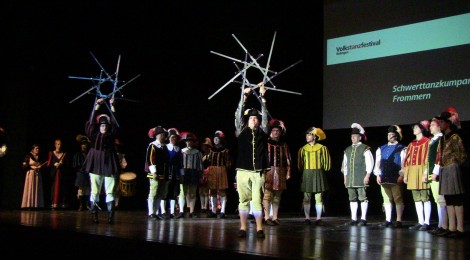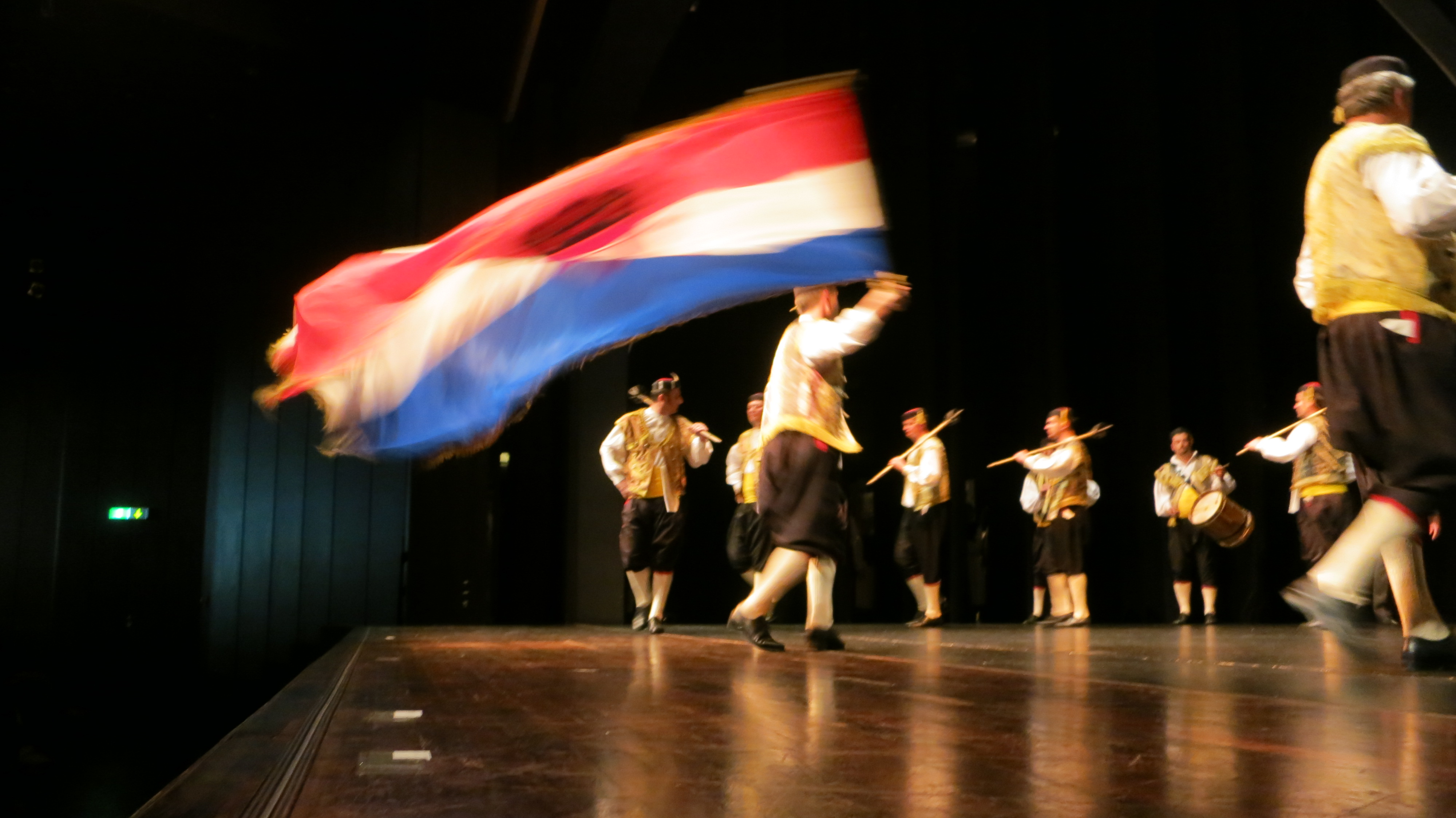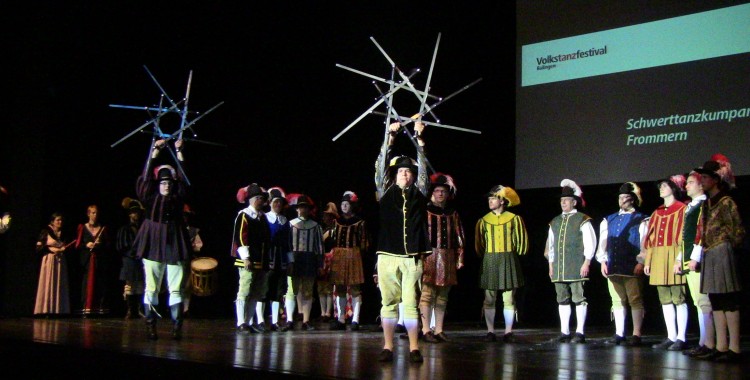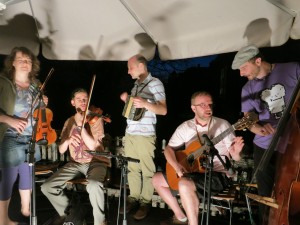
International Sword Spectacular In Germany
After a brief jaunt through Croatia and Bosnia I returned back to Germany to the town of Balingen, just south of Stuttgart, for an International Sword Dance Festival. Unfortunately, due to a dearth of information, I had not much of an idea where it was. I convinced an off-duty bus driver (Banjo music + young daughter=helpful parent) to take me to the headquarters of the organization that was putting on the festival, a few miles outside the center. Upon arriving there I discovered that in fact the performance was happening back where I started, and that the youth hostel where I could stay was closing in ten minutes! Luckily a Croatian man who was waiting for his parents to arrive offered me a lift, and I checked into the youth hostel, grabbed all my gear and sprinted to the performance hall. I missed the (German) introductions, but managed to make it there in time for the performances! The event was split into three days; Friday and Sunday had showcases and Saturday was to be a free day of sightseeing and socializing. To make it easy I will just be describing all the groups together and not splitting them into two separate days. 
From Basque Country came the group Andra Mari, led by a man that I had actually met in Arrate in September! He recognized me when I came backstage and introduced me to the leaders of the German team, for which I was grateful. They performed a few dances, including the set of stick and sword dances from Iurreta which I had seen last year. It was a very different experience seeing the dance done on a stage and watching it in its natural environment, but they were great performers and I enjoyed the dancing greatly.
Less familiar to me were the two groups from Korcula, a Croatian island just north of where I saw sword dancing on Lastovo. First up was Kumpanija Pupnat, led by a flag spinner and carrying swords in elaborately decorated scabbards.
 The dance is one of six Kumpanijas that are performed in different Korčulan towns and is a combination of linked dancing with mock combat style. It starts with the group of dancers marching around the space, lead by a man twirling the croatian flag. They go on to unsheath their swords in a line as a leader dances in front of the group. There is a weaving figure and a few tunnels in zig-zag formation, all directed by the leader who separates from the group at times. It is particularly interesting as it is the only sword dance that I have seen which incorporates mock combat elements such as a challenges and two sides advancing at each other while staying in hilt and point formation. It uses a variety of steps that change throughout the dance.
The dance is one of six Kumpanijas that are performed in different Korčulan towns and is a combination of linked dancing with mock combat style. It starts with the group of dancers marching around the space, lead by a man twirling the croatian flag. They go on to unsheath their swords in a line as a leader dances in front of the group. There is a weaving figure and a few tunnels in zig-zag formation, all directed by the leader who separates from the group at times. It is particularly interesting as it is the only sword dance that I have seen which incorporates mock combat elements such as a challenges and two sides advancing at each other while staying in hilt and point formation. It uses a variety of steps that change throughout the dance. 
The second group from Korčula was the Moreška, who perform in the town of Korčula and are probably the most well known of the different teams. The dance is not hilt and point, but tells the common story of fighting between the Moors (depicted in black) and the Christians (in red). In this version, Bula (the young girl) is captured by Moro (the king of the Moors). She is in love with the Osman, the red king, who enters and tries to take her. This results in a battle between the two sides, with the red dancers acting as the aggressors and black dancers presenting a defending and sometimes cowardly pose. Each dancer carries two short metal swords with a small diamond-shaped bulge at the point. There are several figures and rounds, and the group sometimes performs shortened versions of the dance by removing a few. In the end the black army is slain, or at least defeated, and Bula and Osman walk off together followed by the two armies.
I had a nice reunion with some old friends from the sword dance team in Fenestrelle who had been invited to the weekend. They performed their dance quite well and I thought it was one of the dances that really translated well to the stage.
I liked getting to have a reunion; this trip is great because I am always meeting new people and seeing new things, but it certainly can get tiring. I won’t describe the dance with much detail, but feel free to check out my original post on Fenestrelle!
Next up: Uberlinger. This is the oldest continuously performed sword dance that we have documented, going back to at least 1646! In it’s current form the dancers are dressed in 18th centure garb and carry swords at their sides in scabbards. It has some similarities in choreography to the Bagnasco sword dance, with weaving figures and arches down and up. The dance’s most unusual feature is the Hansel, a devil-like character dressed in rags and brandishing a long whip. According to legend, during the 30-years war, the men of Uberlinger were preparing for battle (against the Swedish, if my historical memory serves) and all went to church before the fight. All, that is to say, except for one. Needless to say, they all survived except for this man, Hansel. With whip in hand he struck a rather terrifying figure, particularly with stage lighting, but some brave children were not intimidated and managed to go say hi anyway!
The dance ended with the women who had been by the sidelines coming out and the whole group doing a set of social dances together. The other German group was the Frommern team who had organized the event. This was a reconstructed dance that was primarily taken from this etching:
This picture is from about 400 years ago in Nuremberg, and is commonly cited in sword dance literature and reconstructions. However, there is one element that I have never seen performed, which is the two platforms of swords with men clashing swords between them that is seen at the top of the picture. The Frommern team was the first group that I have seen to include this, and in spectacular fashion!
There were two hilarious fools and some great dancing as well as speeches and sword clashing on top of the stars. It is worth noting that these were proper locks, not just loose stars, and could be held up and displayed. They were made in an uneven fashion, so that they had rays instead of points. It was quite the dramatic effect!
Moving on to Belgium, we had three of the four teams from the group Lange Wapper (the children’s group couldn’t come) which was founded by one of the greatest sword dance researchers and scholars, Renaat van Craenenbroeck who passed away a few years ago. He was the main choreographer behind the original men’s dance and probably the most knowledgeable person about continental sword dancing. 
It is a wonderful dance, both inovative and rooted in tradition at the same time and I had a great time learning some of it from the dancers. I actually had met some of the dancers at the 2004 Sword Spectacular in Whitby, England and taught them rapper dancing during some of the spare time. I mentioned this and was told that that was one of the things that inspired the women to write a dance of their own, inspired by rapper and longsword.
The final dance was written for the older men to dance when they weren’t able to do the original dance any more (as you can see, it can take a toll on the knees!) It was danced in huge wooden clogs and the leader had bellpads on his shins.
I had a lot of fun with the Belgians during the weekend and even got to do a rapper refresher course (with scarves) during one of the late-night parties! I really hope to visit the team in the future, but it probably won’t be on this trip. Which sort of leads me to one of the questions I have been pondering: How am I planning on continuing this research after my Watson Fellowship ends? I haven’t quite figured it out yet, but I am fairly certain that I want to keep visiting these groups, studying and learning. I think that returning to places will be a very different feeling and I will be able to get a whole new perspective on the dances, cultures and customs.
The final sword group was an extra special treat, the Durmberger sword dancers from Austria. Traditionally the dance of salt miners (the region, near Salzburg, was famous for salt production) it is only performed every four years, and this was one of the first times it had ever been performed outside of that schedule. It is a really interesting dance and each figure is named after a situation or activity in mining. They used props such as a ladder, which the capitan would climb and then slide down, and would form various tableaus before returning to a circling chorus. They also included a double high circle, which is one of the most amazing figures I have seen!
Aside from all of the amazing sword dancing, the weekend was full of socializing, sight-seeing, social dancing and music making. We visited a nearby castle with the Basques and Croatians where we got a tour in slidey slippers and capes and had lunch overlooking the whole countryside.
Every night there was a big dinner and everyone played music from their home country and taught some dances. I played banjo and got to dance zwiefachers, so I was a happy dancer! With so many talented musicians it was always a lively scene until the wee hours. I got to meet and interview lots of the dancers and came away from the weekend with immense satisfaction. Almost as pleased with myself as this fellow!



